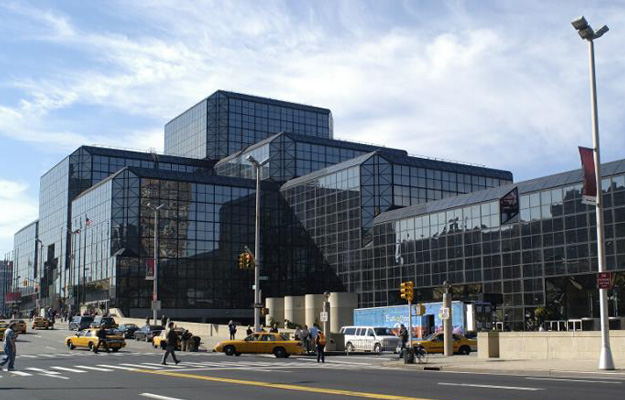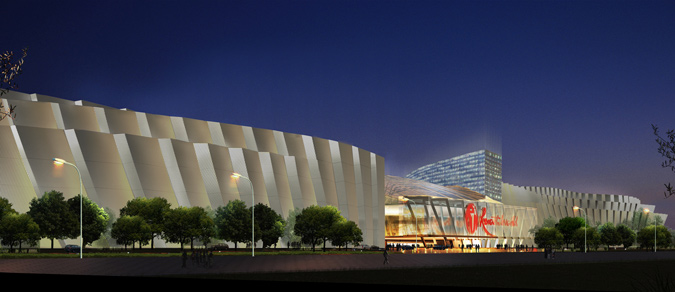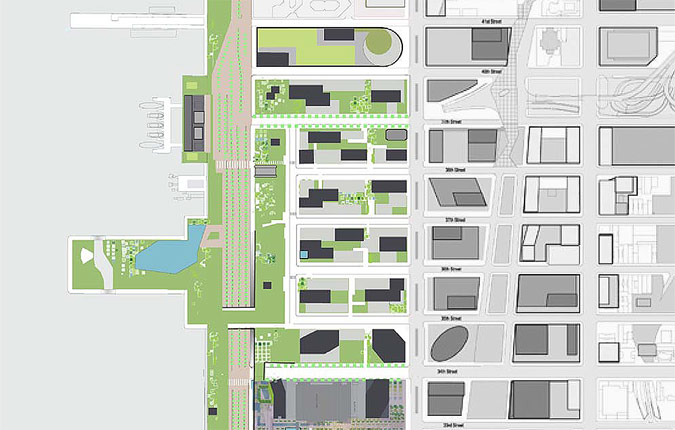While the Javitz Center may be in the midst of a major renovation, the underlying problem with Manhattan’s convention center still needs to be addressed; it simply isn’t big enough. Even the Center’s expansion has been underwhelming, as only 50,000 square feet of the originally proposed 500,000 is being added. The minor addition comes at a huge expense, with $1.3 billion spent on the project.
 |
| Antiquated and undersized, even post-refurbishment: Image via VisitingDC |
Despite the huge pricetag, the refurbished and very slightly larger Javits will still fail to meet the needs of New York convention goers. The exhibit space, a mere 675,000 square feet (pre-renovation), pales in comparison to the country’s major centers–Chicago’s McCormick Place takes the number one spot with over 2.2 million square feet of event space, while Houston rounds out the top 10 with a facility just under 1 million square feet.
The fact of the matter is that the location of Javits is inconvenient to its current and any future plans for expansion. Real estate in Manhattan is simply too expensive to waste land on a facility with such a large footprint–even the Hudson Yards, immediately to the south of Javits, are now being redeveloped. With land at a greater premium than ever, a fantastic solution has already been presented in the dilemma of what New York should do for its new convention center: building an enormous facility at the Aqueduct Racetrack in Queens.
Accessible by train, the site–to be developed by Genting, a Malaysian company–will feature 3.8 million square feet of convention space, in addition to a host of other amenities (among them, 3,000 new hotel rooms). Genting’s proposed development is a fantastic idea for several reasons; New York would finally have the country’s largest convention facility, while an area of Queens that is currently underutilized could be turned into a hub of activity and development. Too often, people assume that nothing exists in New York outside of Manhattan and indeed, concerns exist that Genting’s proposal is simply too far from Times Square to be viable.
 |
| New Aqueduct Convention Center: Image by Arquitectonica via Archpaper |
The concerns are invalid for several reasons. Many convention-goers arrive via airplane, which makes Genting’s proposed location more convenient than Javits, given Aqueduct’s proximity and direct access to JFK via the subway (La Guardia is also a short taxi ride away). Manhattan has enough appeal on its own to withstand the loss of Javits–indeed, the redevelopment of the site could generate significantly more income than any convention center, especially if the site can remain a destination (think of the Empire State Building, or the new/old World Trade Center…). The most compelling argument falls back on putting land to its best use, with Genting’s proposal signalling that land used at a low intensity in Queens has potential economic use far greater than anything in the area at present.
Coming back to Javits itself, the renovation has turned into a financial catastrophe. The cost-overruns have been huge, with the results unimpressive–Manhattan’s supposedly first-class convention center is still a third of the size of Chicago’s, a city that’s only a third the size of New York. Instead of letting the land under Javits go to waste, the city should create a project that solidifies the Hudson Yards plan, developing one of the last frontiers of Midtown. Javitz currently occupies six entire city blocks–a huge amount of land–that could one day satiate Manhattan’s extreme shortage of housing (given the city has the most expensive real estate in the country).
Plans have already been put forth for the eventual redevelopment of Javits, with the plan by the Hell’s Kitchen Neighborhood Assocation seeking to reconnect the waterfront in a Battery Park City-style development. While even something similar to Battery Park City would be optimal over what currently exists, something higher-intensity would be welcome, especially if development could be made contingent on funding of the 7-line station at 41st Street. Completion of the 7-line stop would provide even more convenient access to a neighborhood already a short walk from Penn Station, and would allow for development on a very large scale. Indeed, Javits encompasses 18 acres of land, a huge amount in a city so starved for space.
 |
| Plans put forth by the Hell’s Kitchen Neighborhood Assocation for the Javits redevelopment: Image from HKNA via Archpaper |
Instead of something modest, a bold proposal would do wonders in linking the 42nd Street corridor with the future development at Hudson Yards, in addition to taking advantage of the future rezoning of the East Side (the 41st Street stop on the 7-line is separated from Grand Central by only the Times Square and Bryant Park stops). As Midtown prepares for significant additions of office space, the residential space-crunch will barely be alleviated by the Hudson Yards development, which will feature 20,000 new apartments. In any other American city, 20,000 new apartments would completely saturate the market–New York is a major exception, especially as several large office blocks (in addition to Hudson Yards) will soon be under construction.
In sum, the best use of the space Javits currently sits on would be a massive residential project that would complement the ongoing office developments in Midtown. As of 2012, the Javits Center is uncompetitive on a national scale, offering a fraction of the space compared to venues in Chicago, Las Vegas, and Atlanta, among others. Redeveloping Aqueduct into a massive complex a city like New York deserves is the best option, while transforming Javits into a residential complex that would actually alleviate extremely expensive Manhattan real estate prices. Besides revitalizing the immediate neighborhood, which is currently lacking any form of life or vitality, the Javits’ redevelopment would also reconnect the city to the waterfront from 34th to 40th streets.
The redevelopment of Javits is a question of when, not if. As such, it makes sense to plan for the Center’s demolition and redevelopment in concurrence with the massive project underway at Hudson Yards–creating a neighborhood coherent in vision, scope, and phasing. Redeveloping Javits as soon as possible would make whatever housing is created more affordable than long-term redevelopment, as increasing real-estate value in the neighborhood would encourage more luxury housing over time. The best possible outcome would be a plan that sees the opening of Genting’s new facility concurrent with the closing of Javits.
For more information on both the Genting project and the Javits Center, the following articles are quite informative;
Javits Renovation Plan Doesn’t Go the Way of Client 9, by Eliot Brown of the New York Observer
Convention Experts Assail Plan to Close Javits, by Charles Bagli of the New York Times
Largest U.S. Convention Centers, from Pittsburgh Live via Tradeshow Week
Subscribe to YIMBY’s daily e-mail
Follow YIMBYgram for real-time photo updates
Like YIMBY on Facebook
Follow YIMBY’s Twitter for the latest in YIMBYnews






We need a convention facility that could exceed 2.2 million square feet of event space of Chicago’s McCormick Place. With New York’s revival, we’ll need to add more levels or stories of event space. We may need a new proposal to transform the Jacob Javits Conventional Center into a conventional tower, that could rise 7 – 10 stories of event space that would have 30 feet high ceilings on each floor including a basement and sub-basement levels. This convention center could stand up to around 210 – 300 feet high, but what other choice do we have?
I think the best alternative is the demolition of Javits & the construction of a new convention center in Queens, that could be larger than even 3 MSF. Javits should be redeveloped into mixed-use supertalls, all it needs is the station that will hopefully eventually be built along the 7-extenion at 42nd Street.